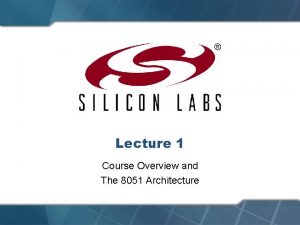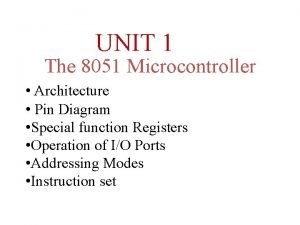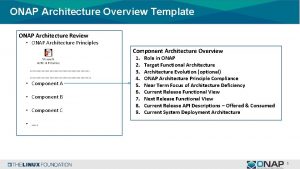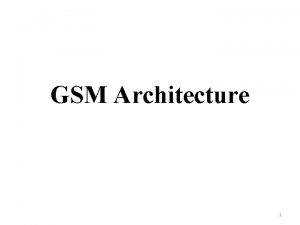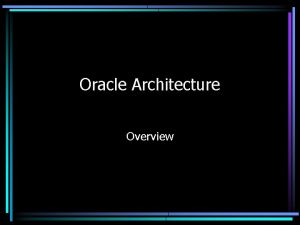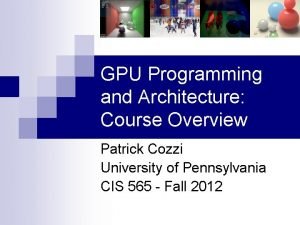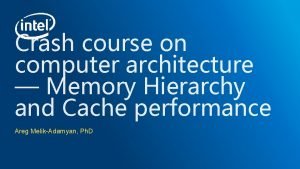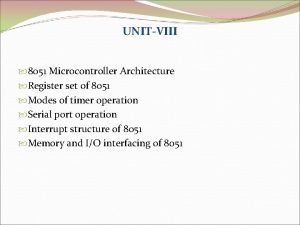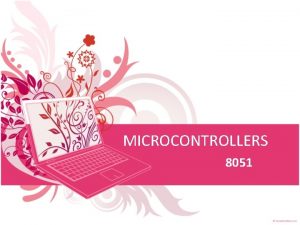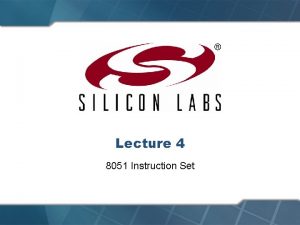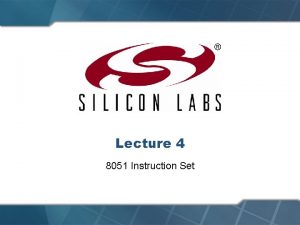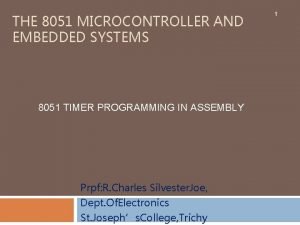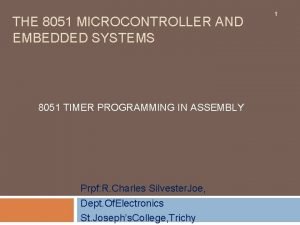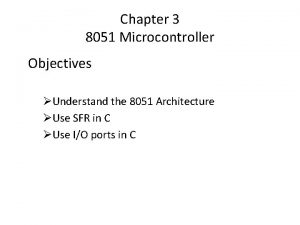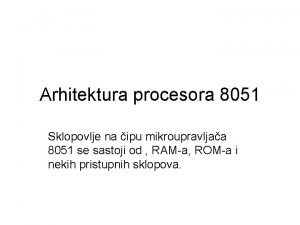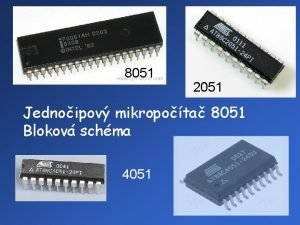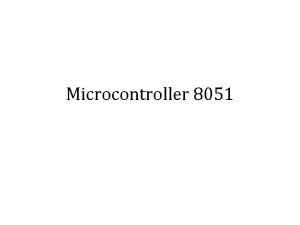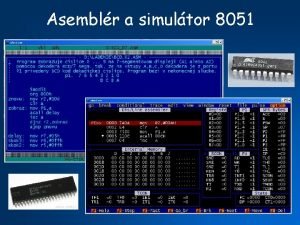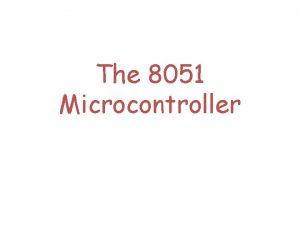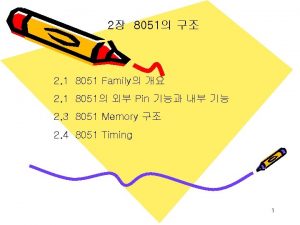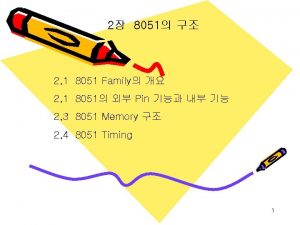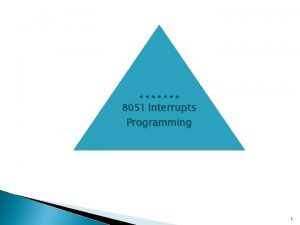Lecture 1 Course Overview and The 8051 Architecture






















- Slides: 22

Lecture 1 Course Overview and The 8051 Architecture

MCUniversity Program Lectures ¨ ¨ ¨ 2 8051 architecture System overview of C 8051 F 020 8051 instruction set System clock, crossbar and GPIO Assembler directives Programming using C language Interrupts Timer operations and programming Serial communication DAC and comparator ADC

Course Syllabus Ø Lectures and Tutorial questions are based on the “Embedded Programming with Field-Programmable Mixed-Signal Microcontrollers” Textbook 3

Course Goals ¨ At the end of this course, you should be able to: Ø Understand the architecture of one of the most popular microcontroller (MCU) families Ø Use an integrated development environment (IDE) to program and debug an MCU Ø Program an MCU using Assembly and C languages Ø Understand use peripherals integrated into an MCU Ø Interface an MCU to simple external components Ø Understand use interrupts Ø Use timers in various modes Ø Communicate using a serial interface Ø Understand use analog to digital converters (ADC), digital to analog converters (DAC) and comparators 4

Course Prerequisites ¨ A course in Electric Circuits that includes understanding basic electronic components such as resistors, capacitors, diodes and transistors ¨ A course in basic digital logic design that includes logic gates and Boolean arithmetic ¨ Ability to program in a high-level programming language such as C or C++ 5

The 8051 Architecture ¨ Microprocessors and microcontrollers ¨ The 8051 microcontroller: a brief history ¨ Block diagram of the original 8051 ¨ Is 8 -bit still relevant? ¨ Harvard and von Neumann architectures ¨ Memory organization ¨ Special function registers 6

Microprocessors and Microcontrollers ¨ Microprocessor: general-purpose CPU Ø Emphasis is on flexibility and performance Ø Generic user-interface such as keyboard, mouse, etc. Ø Used in a PC, PDA, cell phone, etc. ¨ Microcontroller: microprocessor + memory on a single chip Ø Emphasis is on size and cost reduction Ø The user interface is tailored to the application, such as the buttons on a TV remote control Ø Used in a digital watch, TV remote control, car and many common day-to-day appliances 7

Terminology ¨ Integrated Circuit (IC): A miniaturized electronic circuit that consists of semiconductor devices and passive components contained in a package ¨ Central Processing Unit (CPU): This refers to the core of the MCU that executes code ¨ Microcontroller Unit (MCU): This is the standard acronym used for microcontrollers, and refers to the full IC that contains the CPU and peripherals. ¨ “n-bit” – the “n” refers to the data bus width of the CPU, and is the maximum width of data it can handle at a time Ø Examples: 8 -bit MCU, 32 -bit MCU 8

Microcontroller Architectures ¨ Microcontroller architecture refers to the internal hardware organization of a microcontroller ¨ Each hardware architecture has its own set of software instructions called assembly language that allows programming of the microcontroller ¨ Some of the popular microcontroller architectures Ø Intel 8051 Ø Zilog Z 80 Ø Atmel AVR 9

The 8051 Microcontroller—A Brief History ¨ In 1980, Intel introduced the 8051, relevant today after more than two decades ¨ First device in the MCS-51® family of 8 -bit microcontrollers ¨ In addition to Intel there are other second source suppliers of the ICs, who make microcontrollers that are compatible with the 8051 architecture. ¨ In recent years some companies have incorporated many different and additional features into 8051 ¨ In 2000, Silicon Laboratories introduced a field programmable, mixed-signal chip (C 8051 F 020) based on the 8051 core CPU Ø This will be the platform for this course. 10

Is 8 -bit Still Relevant? ¨ “n-bit” – the “n” refers to the data bus width of the CPU, and is the maximum width of data it can handle at a time ¨ PCs with 64 -bit microprocessors are becoming common ¨ Over 55% of all processors sold per year are 8 -bit processors, which comes to over 3 billion of them per year!* ¨ 8 -bit microcontrollers are sufficient and cost-effective for many embedded applications ¨ More and more advanced features and peripherals are added to 8 -bit processors by various vendors ¨ 8 -bit MCUs are well-suited for low-power applications that use batteries *Note: Statistics from Embedded. com Article ID# 9900861, Dec 2002 11

Example System: RC Car 12

Block Diagram of the Original 8051 13

Block Diagram of the Silicon Labs 8051 14

Harvard and von Neumann Architectures ¨ Harvard Architecture—a type of computer architecture where the instructions (program code) and data are stored in separate memory spaces Ø Example: Intel 8051 architecture ¨ von Neumann Architecture—another type of computer architecture where the instructions and data are stored in the same memory space Ø Example: Intel x 86 architecture (Intel Pentium, AMD Athlon, etc. ) 15

MCU Fetch-Execute Cycle ¨ Fetch operation—retrieves an instruction from the location in code memory pointed to by the program counter (PC) ¨ Execute operation— executes the instruction that was fetched during the fetch operation. In addition to executing the instruction, the CPU also adds the appropriate number to the PC to point it to the next instruction to be fetched. 16

8051 and 8052 ¨ The feature set of the 8052 is the superset of the 8051 ¨ In addition to all the features of the 8051, the 8052 includes Ø 128 bytes internal RAM (total of 256 bytes) Ø A third 16 -bit timer, with new modes of operation Ø Additional SFRs to support the third timer ¨ The Silicon Labs C 8051 F 020 builds upon the 8052, and adds further features ¨ The term “ 8051” is typically used in place of “ 8052”, and also refers to the 8051 architecture 17

C 8051 F 020 Data Memory (RAM) ¨ Internal Data Memory space is divided into three sections Ø Lower 128 Ø Upper 128 Ø Special function register (SFR) ¨ There are 384 bytes of memory space physically, though the Upper 128 and SFRs share the same addresses from location 80 H to FFH. ¨ Appropriate instructions should be used to access each memory block 18

Lower 128—Register Banks and RAM General Purpose RAM (80 bytes) Bit-addressable Area (16 bytes) Register Banks (8 bytes per bank; 4 banks) 19

Special Function Registers (SFRs) ¨ SFRs provide control and data exchange with the microcontroller’s resources and peripherals ¨ Registers which have their byte addresses ending with 0 H or 8 H are byte- as well as bit- addressable ¨ Some registers are not bitaddressable. These include the stack pointer (SP) and data pointer register (DPTR) 20

Summary of SFRs ¨ Accumulator (ACC) and B register Ø ACC (also referred to as A) is used implicitly by several instructions Ø B is used implicitly in multiply and divide operations Ø These registers are the input/output of the arithmetic and logic unit (ALU) ¨ Program status word—PSW Ø Shows the status of arithmetic and logical operations using multiple bits such as Carry Ø Selects the Register Bank (Bank 0 - Bank 3) ¨ Stack pointer—SP ¨ Data pointer—DPTR (DPH and DPL) Ø 16 -bit register used to access external code or data memory ¨ Timer Registers—TH 0, TL 0, TH 1, TL 1, TMOD, TCON Ø Used for timing intervals or counting events ¨ Parallel I/O Port Registers—P 0, P 1, P 2 and P 3 ¨ Serial Communication Registers—SBUF and SCON ¨ Interrupt Management Registers—IP and IE ¨ Power Control Register—PCON 21

www. silabs. com/MCU
 01:640:244 lecture notes - lecture 15: plat, idah, farad
01:640:244 lecture notes - lecture 15: plat, idah, farad Course number and title
Course number and title 8051 architecture diagram
8051 architecture diagram Pin function of 8051 microcontroller
Pin function of 8051 microcontroller Architecture review template
Architecture review template Stylistic overview of painting
Stylistic overview of painting Gsm radio architecture
Gsm radio architecture Overview of grid architecture
Overview of grid architecture Overview of oracle architecture
Overview of oracle architecture Computer architecture notes
Computer architecture notes Isa vs microarchitecture
Isa vs microarchitecture Soldier course vs sailor course
Soldier course vs sailor course Chaine parallèle muscle
Chaine parallèle muscle Gpu architecture course
Gpu architecture course Computer architecture crash course
Computer architecture crash course Data centered architecture
Data centered architecture Hình ảnh bộ gõ cơ thể búng tay
Hình ảnh bộ gõ cơ thể búng tay Bổ thể
Bổ thể Tỉ lệ cơ thể trẻ em
Tỉ lệ cơ thể trẻ em Chó sói
Chó sói Chụp tư thế worms-breton
Chụp tư thế worms-breton Hát lên người ơi alleluia
Hát lên người ơi alleluia


